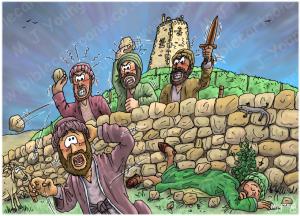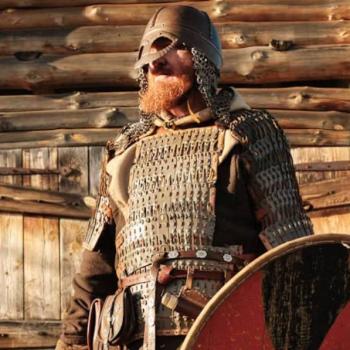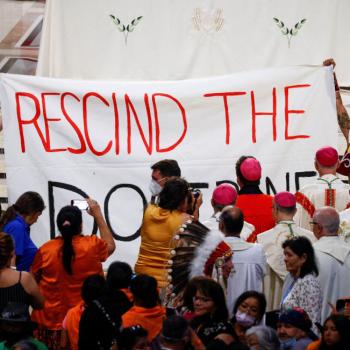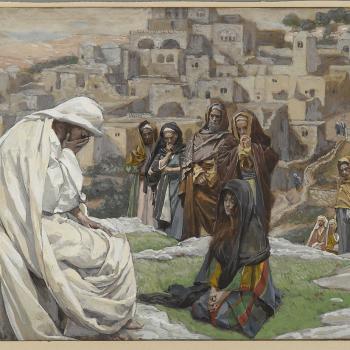
Sometimes in real life it’s hard to tell the good guys from the bad guys. It can be the same in a parable that Jesus tells. The Parable of the Wicked Tenants may be a story of the bad guys and the really bad guys – just like in real life. In a series of posts I’m thinking about Parables as Subversive Speech, following William Herzog’s book by that title. (See note below.) Previous posts in the series:
- William Herzog Reads Jesus’ Parables, Brings them Down to Earth
- Paulo Freire, the “Pedagogue of the Oppressed”: Is This a Good Fit for Jesus?
- Laborers in the Vineyard: A Reading that Doesn’t Blame the Victims
Herzog takes a parable out of its setting in the Gospel and places it in the world where and when Jesus lived. A big part of Herzog’s interpretive technique is to imagine the response of Jesus’ listeners. Jesus knew how his listeners thought; he was one of them. Herzog thinks that Jesus’ stories would have gotten the oppressed poor of Palestine to think for themselves about their situation and lowly status. If he’s right, then that must be what Jesus intended. At the end of the previous post in this series, I considered how the Parable of the Laborers in the Vineyard seems well-designed for that result. A provocative question at the end of the wicked tenants’ story could have accomplished the same.
Are the parables allegories?
The history of parable interpretation does not often see Jesus’ listeners as thinking for themselves. Commonly one sees a parable as allegorical, a story where many details stand for something other than what they literally are. For instance, seed sown becomes the word of God preached. Different soils become different dispositions of the hearers of the word. This style of parable interpretation begins as early as the Gospel writers themselves. It gives a story an obvious meaning, if not to the crowd that first heard the story, then at least to a Gospel reader. Once you get the referents of the story details, you know exactly what to think. But was that Jesus’ style? Or was allegorizing something the Gospel writers or their sources added to address the needs of their communities? (Such use of history was common in the ancient world and not unknown today in the literary genre we call historical fiction. I imagine God is OK with the presence of historical fiction in his book.)
I have to say that the story of the Wicked Tenants is one that easily turn into allegory. That, in fact, is what we see in our first written record of the story in Mark’s Gospel.
The story allegorically interpreted
A man plants a vineyard and leases it to tenant farmers. At harvest time he sends a series of servants to collect his share of the produce. Each servant in turn gets rough treatment from the tenants but none of the landlord’s share of the crop. Some servants they even kill. At last the owner of the vineyard sends his son, thinking they will surely respect him. Far from respecting, the tenants kill the “beloved son” and imagine that now they will inherit the vineyard.
Jesus has been speaking to or, at least, in the hearing of priests, scribes and elders. He had just embarrassed them in front of a crowd of common people. Now he ends a parable with a quote from Scripture: “The stone that the builders rejected has become the cornerstone.” The religious leaders realize that he has told the parable against them. They are the wicked tenants assigned to take care of a “vineyard” that God planted. In Jewish Scriptures a vineyard often represents the people of Israel. They have failed to take proper care of God’s people in spite of the warnings of many prophets – the servants that the landlord sends again and again. They even contrived to turn their stewardship of God’s people into gain for themselves. Written about 40 years after the event, Mark’s story frames these religious leaders as the ones who killed God’s “beloved Son.”
Jesus concludes the parable with the logical response of the landlord: He will “put the tenants to death and give the vineyard to others.” The others, of course, in Mark’s reckoning, represent a new community, gathering in Mark’s time around the memory of Jesus. In this allegorical reading, Jesus is the cornerstone that the Jewish leaders rejected.
Why so many servants?
Most scholars, though not all, think Jesus didn’t tell allegories. His style was a simple story with one point that didn’t rely on all sorts of allegorical connections. Unfortunately, that one point has been a point of disagreement among interpreters. Herzog thinks the problem is they’re looking for a message outside of the story itself. Perhaps the stories are about what they say they are about, namely, life among rich and poor, powerful and powerless, in a complex agricultural society.
Applying the story to the situation of a Christian community that was becoming separate from the majority of jews may have been Mark’s idea. If so, it would have been important to find support for the new Christian way in Israel’s Scriptures. Jesus found the prophets especially close to his thinking. They often found much to criticize about Israel’s and Judah’s leaders. And there were lots of prophets.
Wanting to bring prophets into his version of Jesus’ story, Mark might have wanted more than three plus Jesus. In the story one servant is beaten and sent away empty. A second is “beat over the head and treated shamefully.” A third is killed. And then we have
So, too, many others; some they beat, others they killed. (Chapter 12, Verse 5b)
That second half of Verse 5 is a literary problem. It spoils the story-telling momentum going from a beating to a beating plus shameful treatment to a murder and, finally, to a murder of a beloved son. Whereas in stories you expect to find threes, this adds an awkward fourth item to the list of pre-Jesus “prophets.” Jesus is a better storyteller than that.
Slicing and dicing the parable
Herzog joins a number of scholars in proposing that Verse 5b was not in the parable as Jesus told it. That opens the possibility that the servants may originally have been just servants and not stand-ins for prophets. A simple problem with identifying the servants with prophets is that the prophets of Israel generally didn’t get killed. Likewise, I think, the “beloved son” may have been just a son, not a figure representing Jesus. Mark could have added “beloved.” Twice in Mark’s Gospel Jesus is called God’s “beloved Son.” The last outrageous murder by the tenants, of course, brings to mind Jesus’ own death by crucifixion. Mark’s community knew how Jesus died, but Jesus may not have been thinking that far ahead.
Another issue for Bible interpreters is where Jesus’ story probably ended. Herzog thinks Jesus stopped in the middle of Verse 9 in our Bibles. We have just heard about the tenants killing the son and throwing him out of the vineyard. Then Jesus asks rhetorically:
What then will the owner of the vineyard do? (Verse 9a)
Mark has Jesus continue and give the answer to his own question:
He will come, put the tenants to death, and give the vineyard to others. (Verse 9b)
I think I know why Herzog slices this half verse out of the parable. If Jesus wanted to get his listeners thinking for themselves, as Herzog suggests, he would not have answered his own question. He would have sat back and watched the discussion and, likely, arguments that followed. Some of these debaters likely had jobs similar to the vineyard tenders. They’d have plenty to say, including about their boss. But that points us toward Herzog’s nontraditional interpretation of the Parable of the Wicked Tenants. The boss won’t represent God. He isn’t even a good person.
The Parable of the Wicked Tenants as Jesus may have told it (Mark 12:1-5a, 6-9a)
This telling omits Verse 5b and the word “beloved.”
A man planted a vineyard, put a hedge around it, dug a wine press, and built a tower. Then he leased it to tenant farmers and left on a journey.
At the proper time he sent a servant to the tenants to obtain from them some of the produce of the vineyard. But they seized him, beat him and sent him away empty. Again he sent them another servant. And that one they beat over the head and treated shamefully. He sent yet another whom they killed.…
He had one other to send, a … son. He sent him to them last of all, thinking, ‘They will respect my son.’ But those tenants said to one another, ‘This is the heir. Come, let us kill him, and the inheritance will be ours.’ So they seized him and killed him and threw him out of the vineyard.
What, then, will the owner of the vineyard do [to those wicked tenants]?
The wicked tenants in a spiral of violence
Herzog sympathizes with the “wicked” tenants. His title for Chapter Six in Parables as Subversive Speech is “Peasant Revolt and the Spiral of Violence.” There are three violent scenes in the parable. In the middle the tenants treat the landlord’s messengers violently. At the end there’s the violent reprisal by the landlord. But the story also begins with a kind of violence, not immediately visible to us:
A man planted a vineyard, put a hedge around it, dug a wine press, and built a tower.
Jesus practically spells it out with all these details. The man is rich, and he’s going to make more money with a luxury crop on a field he recently acquired. To Jesus’ listeners this gain by a rich man means loss for a poor peasant. For generations untold his family has eked out a precarious existence on this piece of land. Now, because of a debt he can’t pay, probably because of bad weather and a poor crop, he has lost his family’s patrimony. Before he was a poor subsistence farmer. Now as just one of many laborers on another person’s land, he’s lucky if he can support his family at all. The violence he experiences is the violence of an economic system that extracts as much as it can from the poor for the benefit of the rich.
Jesus’ audience knows the story all too well. We might be surprised when the workers engage in violence, but they’re not surprised. The picture is one of peasant revolt against a system that crushes them.
But the revolt never amounts to a revolution. Peasants don’t have that kind of power. What will the owner of the vineyard do? The question answers itself. Peasants have revolted before only to be put down mercilessly by the powers that be.
What is Jesus trying to do?
Mark says Jesus was aiming the parable at some chief priests, scribes, and elders, who were within earshot. And they knew it. They didn’t like being cast as the wicked tenants, but they could do nothing because of the crowd.
But maybe Jesus’ tenants are just tenants. Or maybe Jesus intended not religious leaders but the poor people listening to identify with the tenants in the story. After all, it’s only we who call the tenants wicked. (Matthew, in his version of the parable, styles them “wretched” at one point – which is about the same as wicked.)
Interestingly, Jesus doesn’t mention the first violence of the economic system; it’s understood. He skirts over the last violence of the landowner’s revenge with just a question, whose answer also goes without saying. “What, then, will the owner of the vineyard do?” But he drags out over four mini scenes the middle violence of the vine tenders. This is the violence that, at times of direst straits, becomes a very real option for poor people in Palestine.
Jesus’ parable, then, names the stressful conditions weighing down on some of his favorite people and the tempting violent response. With a mere question he brings to mind what deep down everybody knows: violence is worse than useless.
Does that mean the poor of Palestine should just accept their lot in this life and wait for something better in the next? I suppose the conversation that follows the parable could include that thought, but probably much more than that.
The wicked tenants’ story is the second of five parables that Herzog says “codify” the life of Palestine’s poor not as fate but as unjust oppression. After those five, in Herzog’s book, come another four that codify resistance and the power that poor people actually have and wield.
Note: I’m working with an online version of Herzog’s book. That has made it impossible to give citations with page numbers.












